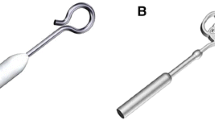Abstract
The aim of this study was an evaluation of the mid-term hearing results after the implantation of a self-crimping heat memory Nitinol piston in stapes surgery. The 12-month postoperative results were compared with those at a minimum of 3 years (maximum 6.7, average 4.4 years). The medical records of all 44 patients who underwent surgery with a Nitinol piston for stapes fixation between November 2005 and January 2007 were evaluated retrospectively. The prostheses used in all cases measured either 4.5 or 4.75 × 0.6 mm. We hypothesized that the 12-month postoperative hearing results would be permanent after an average follow-up of 4.4 years. Thirty-two of the 44 consecutive patients were females and 12 were males. Their mean age was 40.4 years (range 27–69). All underwent a 12-month postoperative audiometric evaluation. 38 (30 females, 8 males, average age 45, range 28–77 years) of the 44 were available for mid-term 4.4-year (minimum 3 years, maximum 6.7 years) postoperative audiometric evaluation. The mean air–bone gap (ABG) for the frequencies 0.5, 1, 2 and 3 kHz at the 12-month postoperative follow-up was 11 dB (SD 4.1) and that after an average 4.4-year postoperative evaluation was 6.4 dB (SD 3.6). The mean decrease in ABG after 12 months was 19.5 dB, and that after the average 4.4 years was 21.3 dB. ABG closure within 10 dB was achieved in 77.2 % after 12 months and in 89.5 % after the average 4.4 years. No patient with an ABG > 20 dB was recorded after the average 4.4 years. The mean air conduction threshold at 4 kHz was examined pre and postoperatively so as to indicate any possible inner ear damage. At the 12-month follow-up, the difference between the pre and postoperative values was −2.5 dB, whereas after the average 4.4 years the difference was surprisingly +13 dB. The individual AC improvements were also demonstrated with the use of Amsterdam Hearing Evaluation Plots (AHEPs). The Nitinol prosthesis allowed excellent intraoperative handling and no postoperative complication was reported. As compared with conventional stapes prostheses, the Nitinol-based SMart prosthesis is a safe and reliable stapes prosthesis. Our mid-term audiometric evaluations revealed that the audiometric parameters demonstrated a hearing improvement between the postoperative 12-month and average 4.4-year examinations. We consider the elimination of manual crimping and the use of a “non-touch” hand-held laser technique has a positive impact on the mid-term audiometric results. Most of the previous studies presented only relatively short-term (from 6 weeks up to 6–12 months) audiometric evaluations. Complications are rare, but a longer follow-up is needed to establish the long-term stability.


Similar content being viewed by others
References
Häusler R (2004) Advances in stapes surgery. In: Jahnke K (ed) Middle ear surgery. Recent advances and future directions. Thieme, Stuttgart, pp 95–133
Rajan GP, Diaz J, Blackham R et al (2007) Eliminating the limitations of manual crimping in stapes surgery: mid-term results of 90 patients in the Nitinol stapes piston multicenter trial. Eur Arch Otorhinolaryngol 11:236–1239
Huber AM, Ma F, Felix H et al (2003) Stapes prosthesis attachment: the effect of crimping on sound transfer in otosclerosis surgery. Laryngoscope 113:853–858
Wiet RJ, Battista RA, Wiet RM, Sabin AT (2013) Hearing outcomes in stapes surgery: a comparison of fat, fascia, and vein tissue seals. Otolaryngol Head Neck Surg 148:115–120
Wengen DF (2007) A new self-retaining titanium clip stapes prosthesis. Adv Otorhinolaryngol 65:184–189
Bauer M, Pytel J, Vóna I, Gerlinger I (2011) Long-term results of the use of autogenous cortical bone columellas to replace the stapes at stapedectomy. Eur Arch Otorhinolaryngol 268:671–675
Roosli C, Schmid P, Huber AM (2011) Biocompatibility of nitinol stapes prosthesis. Otol Neurotol 32:265–270
Fayad JN, Semaan MT, Meier JC, House JW (2009) Hearing results using the SMart piston prosthesis. Otol Neurotol 30:1122–1127
Gerlinger I, Tóth M, Bakó P, Németh A, Pytel J (2008) KTP-laser stapedotomy with a self-crimping, thermal shape memory Nitinol SMart piston: 1 year follow-up results: how we do it. Clin Otolaryngol 33:475–480
Harris JP, Gong S (2007) Comparison of hearing results of nitinol SMart stapes piston prosthesis with conventional piston prostheses: postoperative results of nitinol stapes prosthesis. Otol Neurotol 28:692–695
Babighian G, Fontana M, Caltran S, Ciccolella M, Amadori M, De Zen M (2007) The heat-activated stapes prosthesis ’SMart’ Piston: technique and preliminary results. Adv Otorhinolaryngol 65:190–196
Hornung JA, Brase C, Bozzato A, Zenk J, Iro H (2009) First experience with a new titanium clip stapes prosthesis and a comparison with the earlier model used in stapes surgery. Laryngoscope 119:2421–2427
Huber AM, Schrepfer T, Eiber A (2012) Clinical evaluation of the NiTiBOND stapes prosthesis, an optimized shape memory alloy design. Otol Neurotol 33:132–136
American Academy of Otolaryngology, Head and Neck Surgery (1995) Committee on hearing and equilibrium guidelines for the evaluation of results of treatment of conductive hearing loss. Otolaryngol Head Neck Surg 113:186–187
de Bruijn AJG, Tange RA, Dreschler WA (2001) Efficacy of evaluations of audiometric results after tapes surgery in otosclerosis: II. A method for reporting results from individual cases. Otolaryngol Head Neck Surg 124:84–89
Lesinski SG (2002) Causes of conductive hearing loss after stapedectomy or stapedotomy: a prospective study of 279 consecutive surgical revisions. Otol Neurotol 23:281–288
Ying YM, Hillman TA, Chen DA (2010) Patterns of failure in heat activated crimping prosthesis in stapedotomy. Otol Neurotol 32:21–28
Lagleyre S, Calmels MN, Escude B, Deguine O, Fraysse B (2009) Revision stapes surgery: the “lateralized piston syndrome”. Otol Neurotol 30:1138–1144
Vincent R, Rovers M, Zingade N, Oates J, Sperling N, Deveze A, Grolman W (2010) Revision stapedotomy: operative findings and hearing ressults. A prospective study of 652 cases from the otology–neurotology database. Otology Neurotology 31:875–882
Brown KD, Gantz BJ (2007) Hearing results after stapedotomy with a nitinol piston prostheses. Arch Otolaryngol Head Neck Surg 133:758–762
Hornung JA, Brase C, Bozzato A, Zenk J, Schick B, Iro H (2010) Retrospective analysis of the results of implanting Nitinol pistons with heat crimping piston loops in stapes surgery. Eur Arch Otorhinolaryngol 267:27–34
Tenney J, Arriaga MA, Chen DA, Arriaga R (2008) Enhanced hearing in heat-activated-crimping prosthesis stapedectomy. Otolaryngol Head Neck Surg 138:513–517
van Rompaey V, Yung M, Claes J et al (2010) Heat crimping nitinol versus manually crimping prostheses in stapes surgery for otosclerosis: hearing outcome in a multicenter audit. B-ENT 6:31–36
van Rompaey V, Claes G, Potvin J, Wouters K et al (2011) Systematic review of the literature on Nitinol prostheses in surgery for otosclerrosis: assesment of the adequacy of statistical power. Otol Neurotol 32:354–366
Kasano F, Morimitsu T (1997) Utilization of nickel-titanium shape memory alloy for stapes prosthesis. Auris Nasus Larynx 24:137–142
Gerlinger I, Tóth M, Lujber L, Szanyi I, Móricz P, Somogyvári K, Németh A, Ráth G, Pytel J, Mann W (2009) Necrosis of the long process of the incus following stapes surgery: new anatomical observations. Laryngoscope 119:721–766
Soroma J, Driscoll CLW, Beatty CW et al (2007) Retrospective analysis after stapedotomy with implantation of a self-crimping Nitinol stapes prosthesis. Otolaryngol Head Neck Surg 137:65–69
Shabalovskaya SA (2002) Surface, corrosion and biocompatibility aspects of Nitinol as an implant material. Biomed Mater Eng 12:69–109
Knox GW, Reitan H (2005) Shape-memory stapes prosthesis for otosclerosis surgery. Laryngoscope 115:340–1347
Author information
Authors and Affiliations
Corresponding author
Rights and permissions
About this article
Cite this article
Gerlinger, I., Bakó, P., Piski, Z. et al. KTP laser stapedotomy with a self-crimping, thermal shape memory Nitinol piston: follow-up study reporting intermediate-term hearing. Eur Arch Otorhinolaryngol 271, 3171–3177 (2014). https://doi.org/10.1007/s00405-013-2809-1
Received:
Accepted:
Published:
Issue Date:
DOI: https://doi.org/10.1007/s00405-013-2809-1




